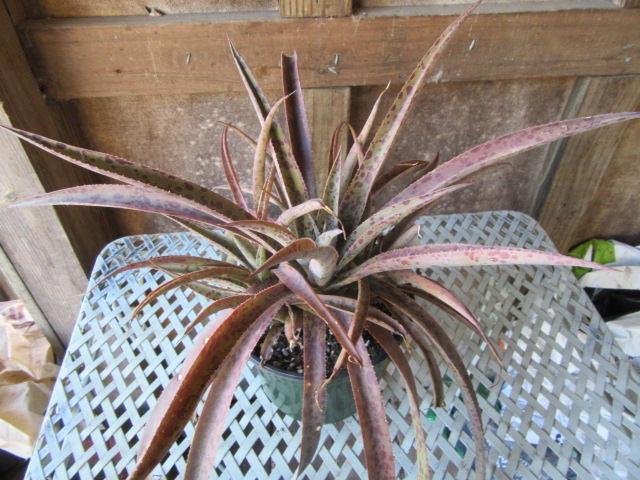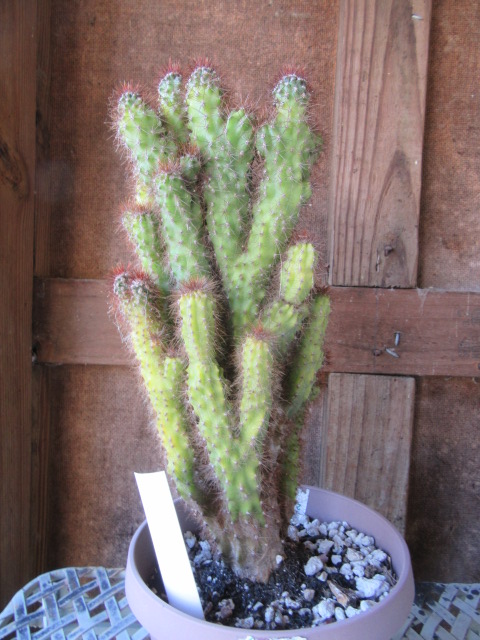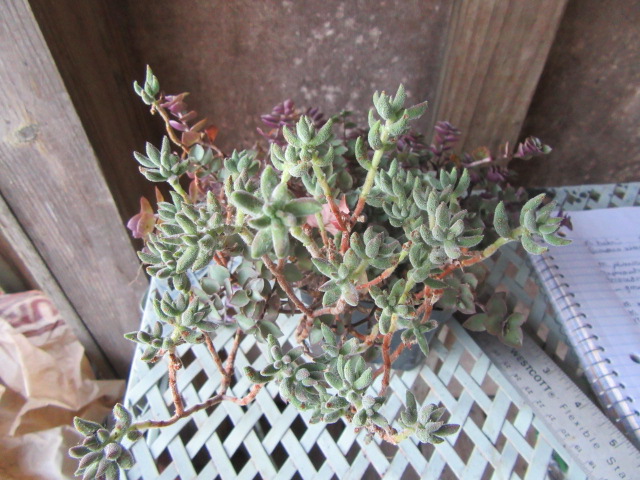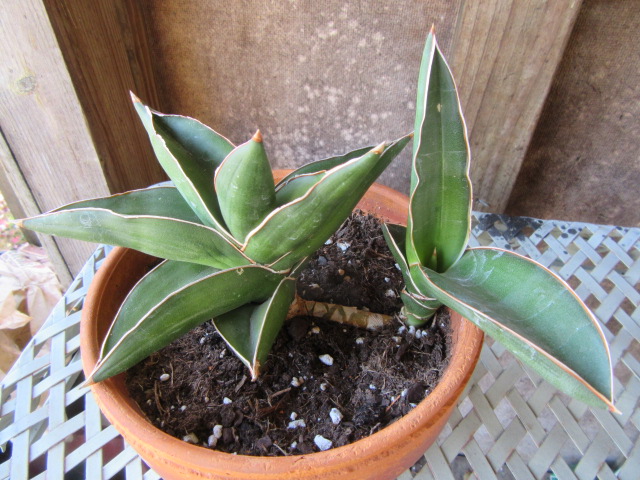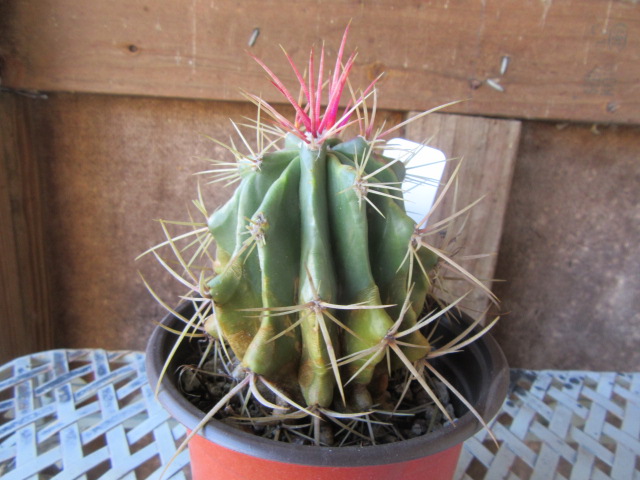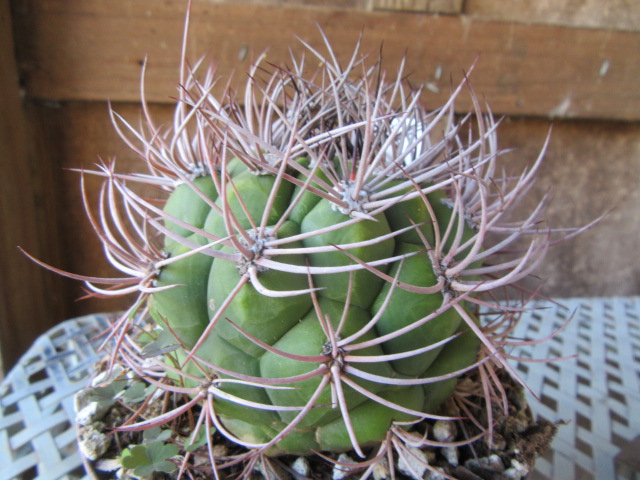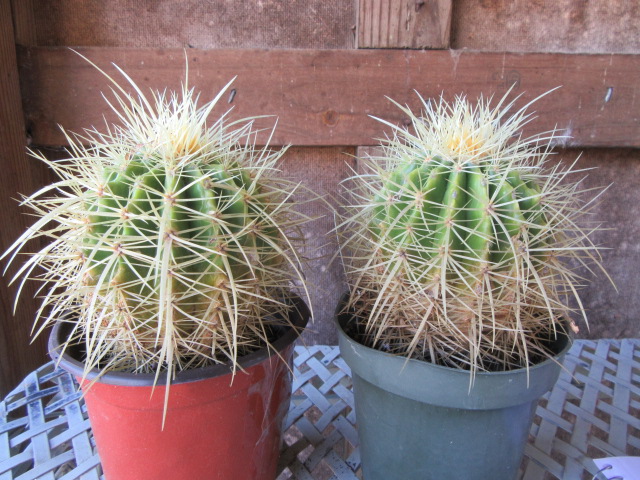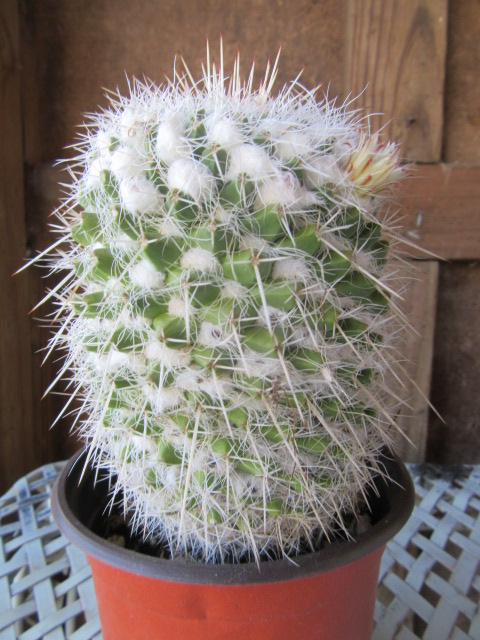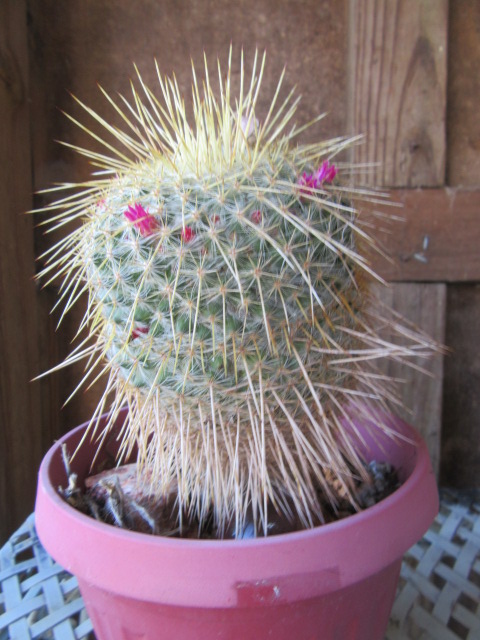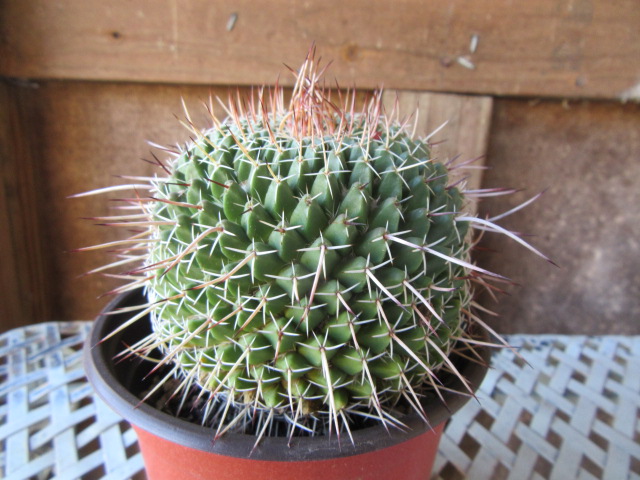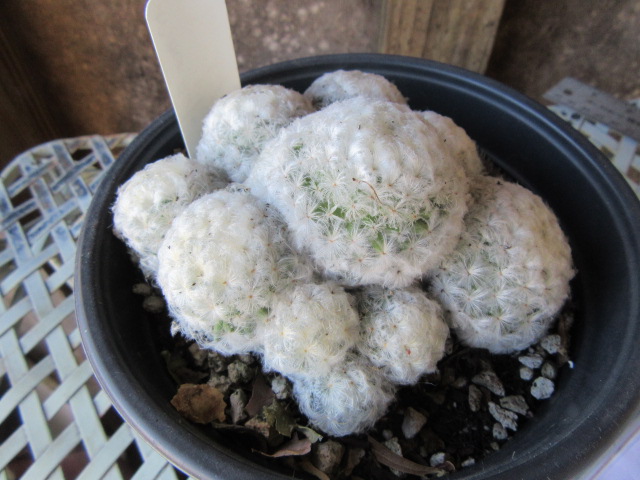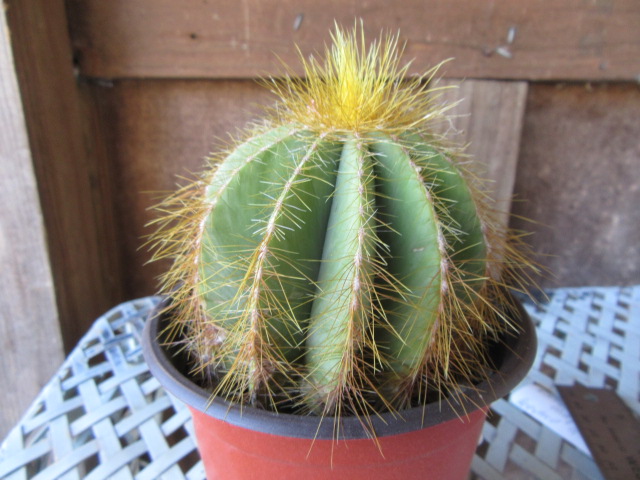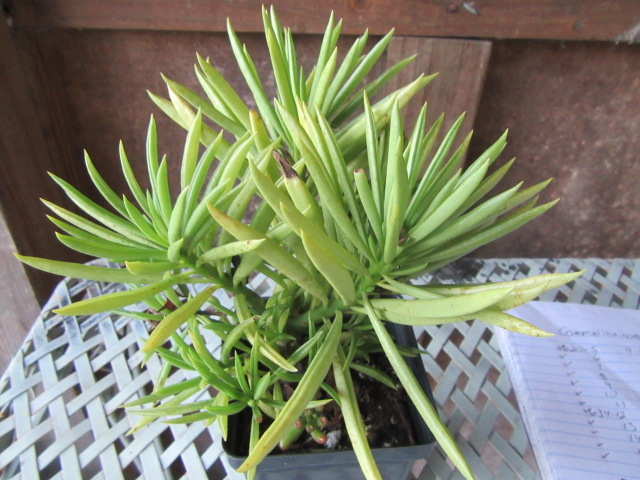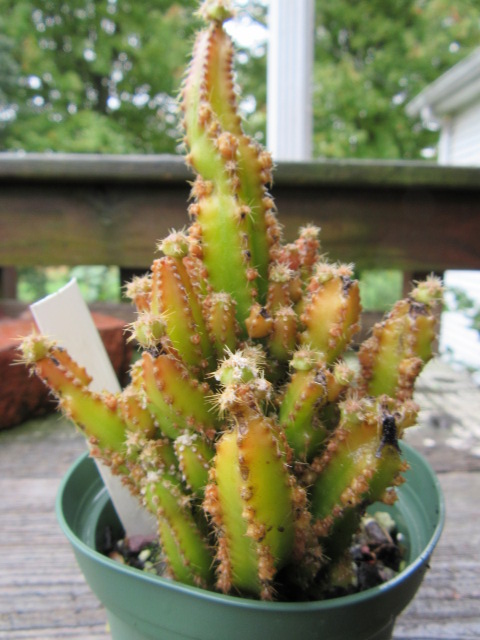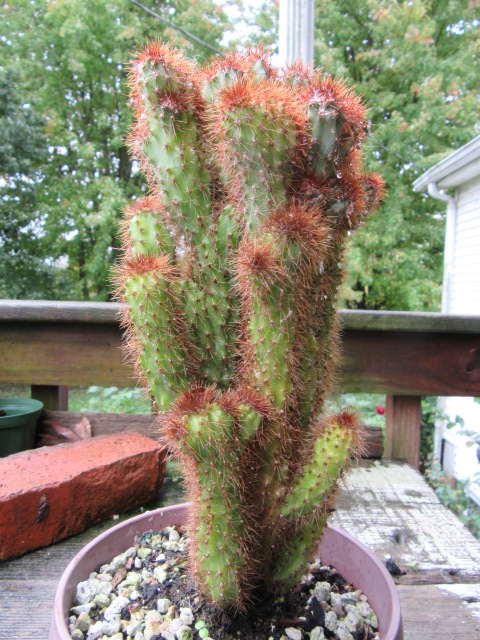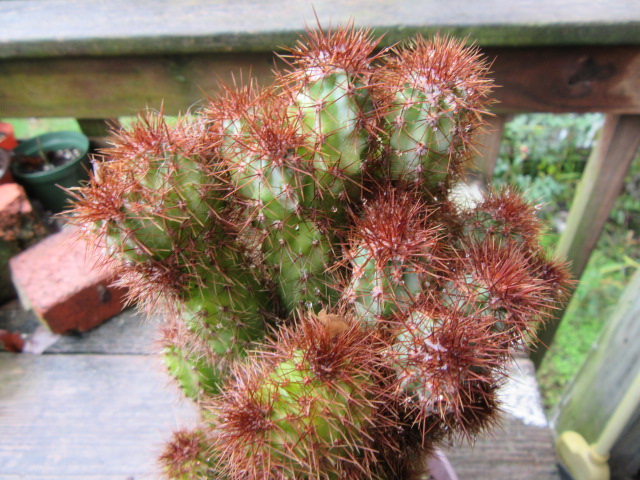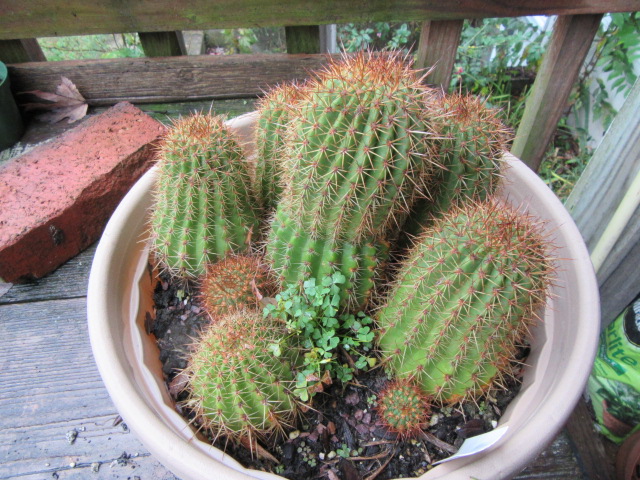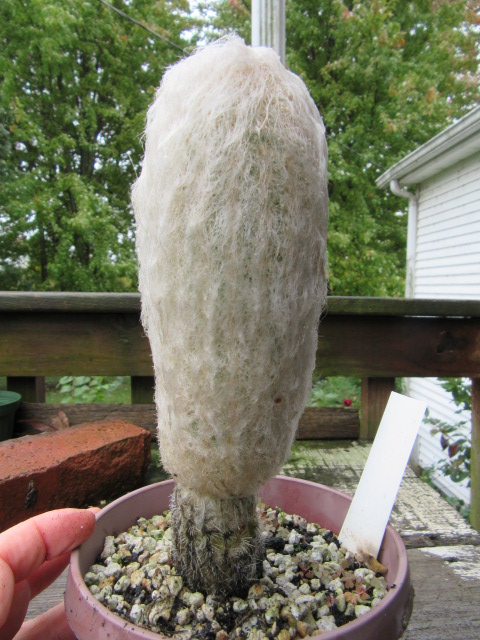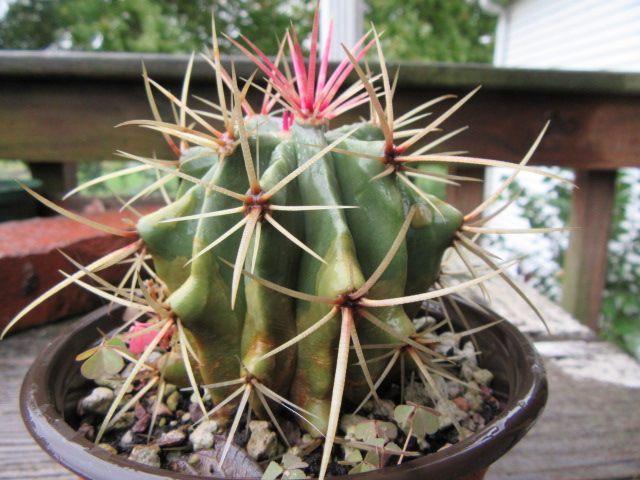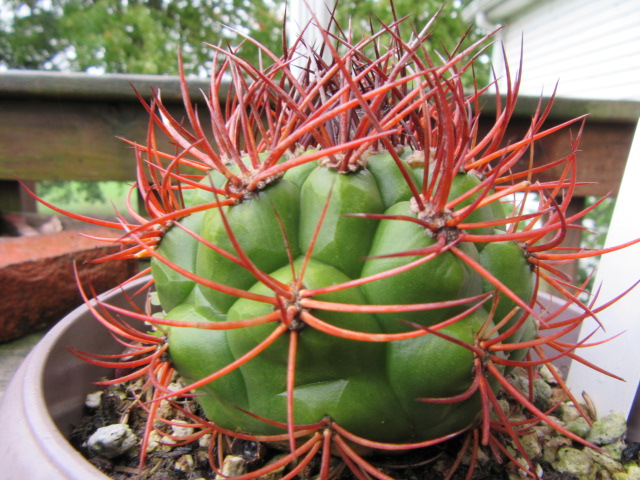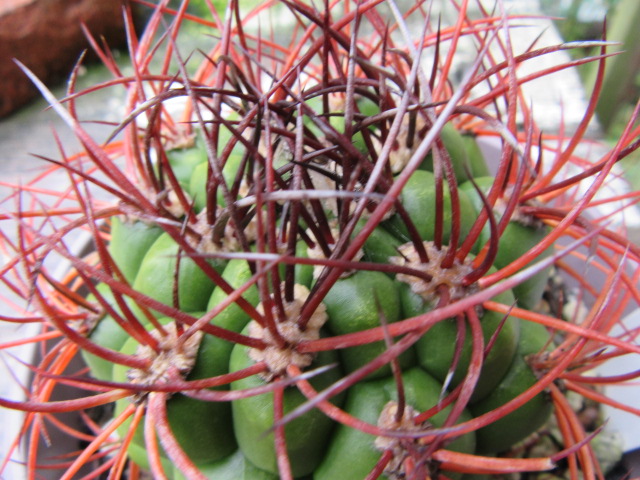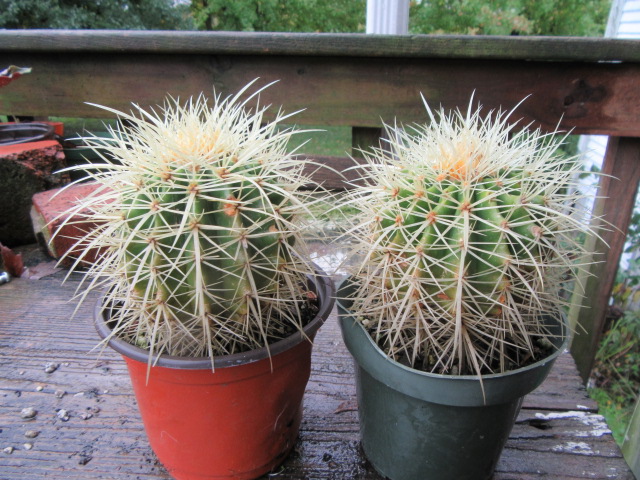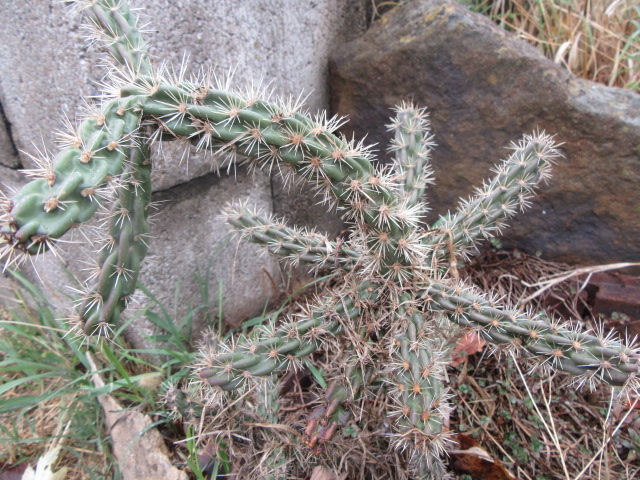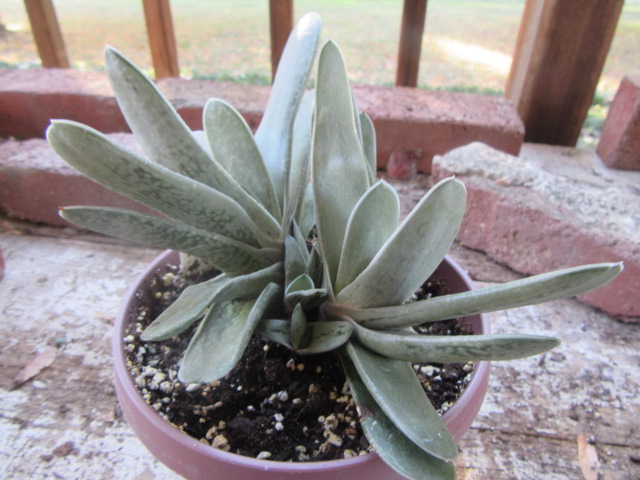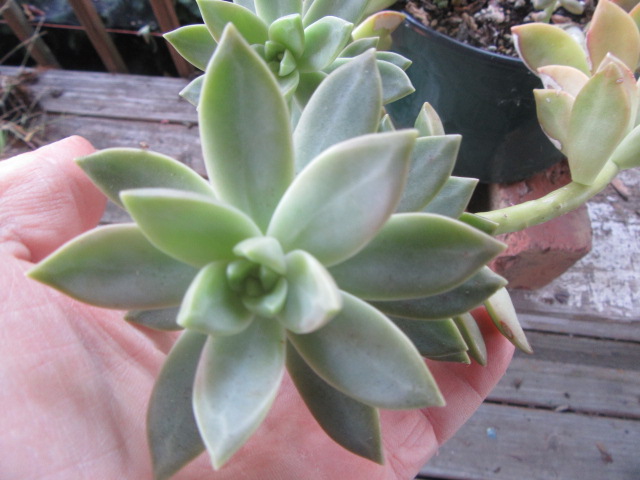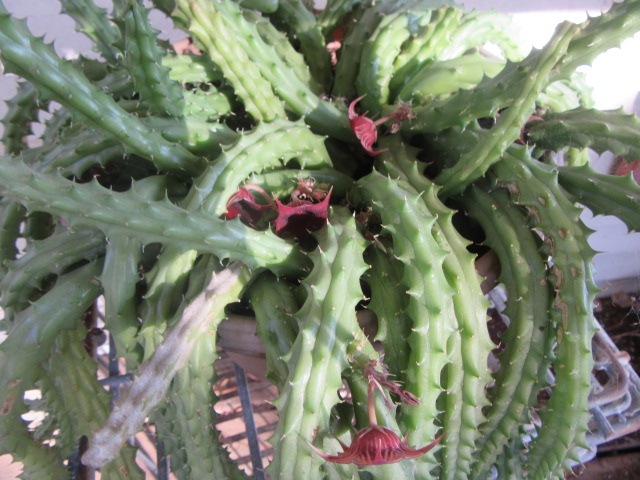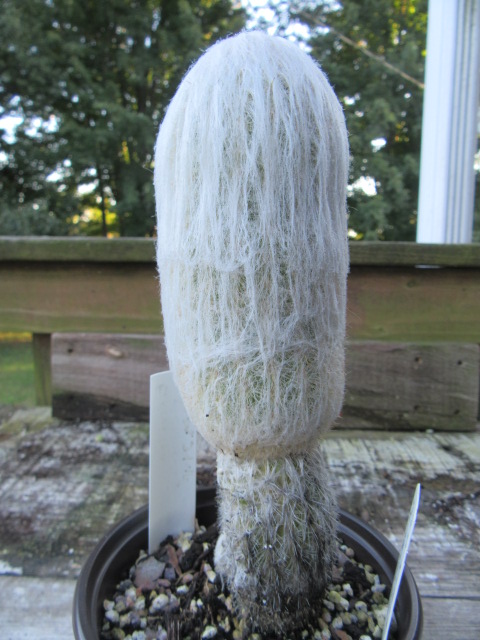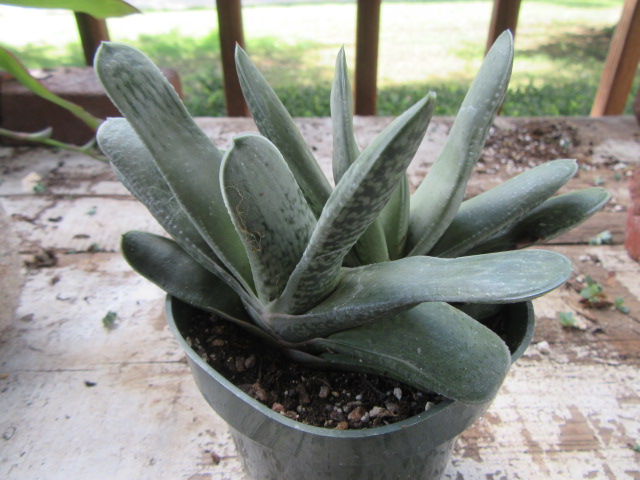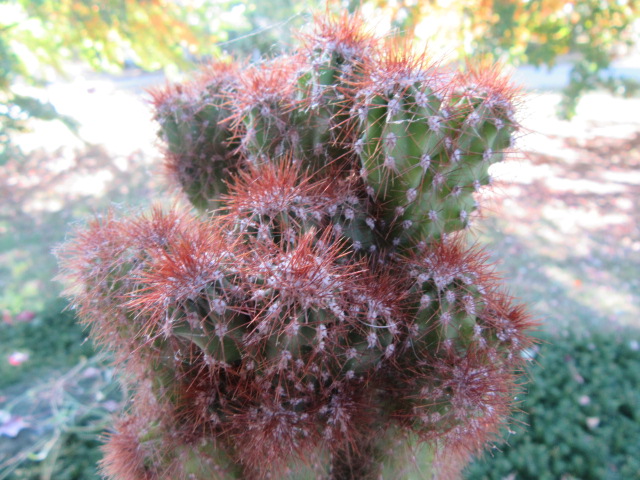
Cereus repandus f. montruosus ‘Rojo’ on 10-16-22, #919-6.
Hello everyone! I hope this post finds you well. The dreaded time of the year has arrived and I had to move the potted plants inside on January 16. I was still working on one last new wildflower ID and still needed a few leaf and stem photos. I had already taken photos, but the leaf and stem photos were blurry. I’m not sure if I can still take any since the “F”, and since then the wind has been blowing. Of course, it warmed back up…
As always, I take photos and measure the cactus and some of the succulents as I bring them back inside. Most of the plants were on the front porch this summer because the heat and the intense sun seemed a little too much for some of them last summer. Yeah, I know they are cacti, but that doesn’t necessarily mean they like intense sun. Many smaller species grow in the shade of taller plants.
Last winter was not too good… My son and his friend were still here so they used the back bedroom. I usually kept the back bedroom cooler with a plant shelf in the south-facing window for the succulents and part of the cacti. but the shelf was placed in front of the east-facing sliding door in the dining room. Instead of the cactus being on a table in front of the sliding door, they were on another shelf in my bedroom. I couldn’t very well keep the temperature cooler in either place. They are gone now, thank goodness, so the plants are basically where they should be.
As a result of more heat, for one thing, I lost a few plants over last winter from mealybugs… GEEZ! I think the worst was losing both Mammillaria pringlei and rhodantha… I also lost the Aloe ‘Lizard Lips’. I had all three of those for MANY YEARS.
Anyway, here we go in alphabetical order… You can click on the plant’s name under the photo to go to their own pages.
<<<<Aloe ‘Cha Cha’>>>>
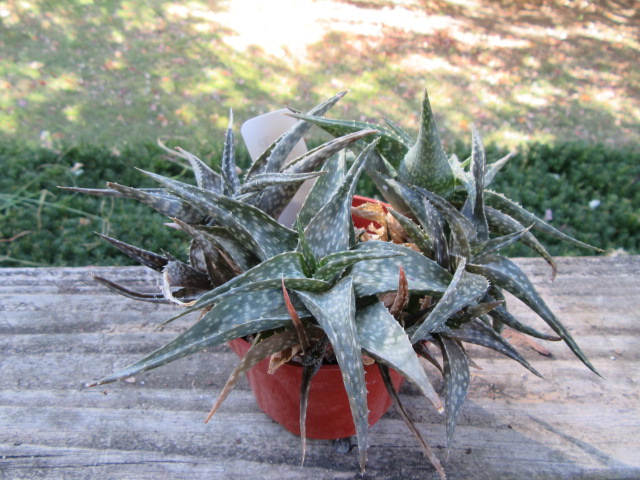
Aloe ‘Cha Cha’ on 10-16-22, #919-1.
Aloe ‘Cha Cha’ is the last survivor of the five plants I received from Succulent Market in 2020. Ummm… I am trying not to mention… No, I’m not going to do it! I did mention A. ‘Lizard Lips’ contacted mealybugs, but not from A. ‘Cha Cha’. Somehow it never had them and has done weirdly well… Of course, as you may be able to tell, it is a miniature.
<<<<Aloe maculata>>>>

Aloe maculata on 10-16-22, #919-2.
Hmmm… I just discovered a problem with starting at the beginning of the alphabet. Maybe I should have started at the end. Although the Aloe maculata are all doing GREAT as always, I have been promising it I would divide their pot for a couple of years. Maybe three. I had one in another pot that “somehow” contacted mealy bugs last winter and they kept coming back. So, I did a terrible thing and threw it out the back door. The big pot was in my bedroom and it would get an occasional bug but nothing serious. Isolating this plant would be a problem, so I decided to put it in the basement in front of a window. I remember I kept a lot of plants in the basement during the winter before and they always did fine. Well, the bugs didn’t like the conditions and they left and the Aloe came through with flying colors like it had been in perfect conditions. These plants are descendants of the Aloe maculata I called ‘Kyle’s Grandma’ that was given to me by a good friend, Kyle, when I was living in Mississippi. The plant, actually I think there were two, were from his grandma, Brenda, in 2009.
I was just thinking maybe I should use the basement as a quarantine station. 🙂 Well, if the plants are halfway dormant…
<<<<Austrocylindropuntia subulata (Eve’s Needle)>>>>
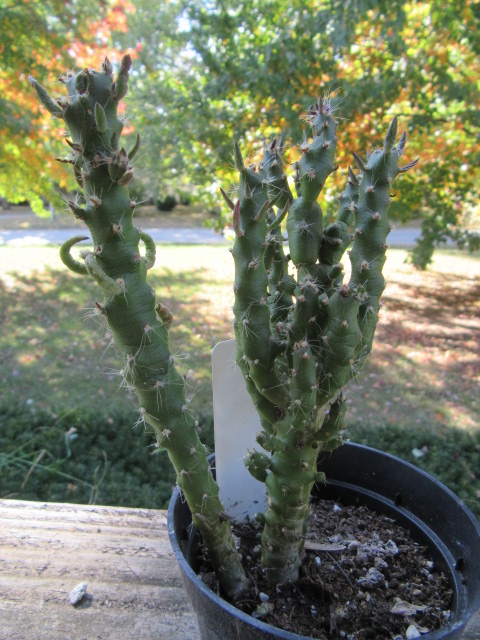
Austrocylindropuntia subulata (Eve’s Needle) at 7″ tall on 10-16-22, #919-3.
Another hmmm… As I looked at this plant, it started tapping its feet. It asked, “Do you notice something?” I said, “Ummm…” Last fall I told this Austrocylindropuntia subulata that I would move it back to the center of the pot in the spring. As you can see, it is still not in the center. Maybe, in the back of my mind, I was thinking it would move by itself. I know the original plant was in the center when I brought it home from Wagler’s Greenhouse in 2019 when it was just a single stub at only 4 1/2″ tall. Now, it has grown appendages and its offset is 7″ tall…
<<<<Cereus repandus f. montruosus ‘Rojo’>>>>
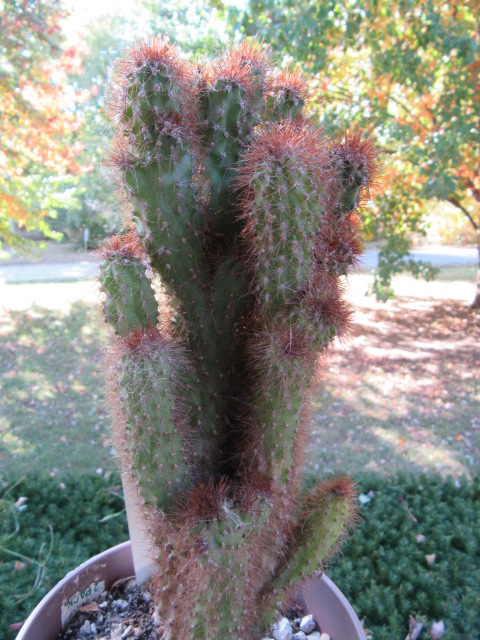
Cereus repandus f. montruosus ‘Rojo’ at 10″ tall x 4 1/4″ wide on 10-16-22, #919-5.
At least the Cereus repandus f. montruosus ‘Rojo’ didn’t give me any dirty looks and seemed to be quite content on the front porch. It grew another 1/4″ and is now 10″ tall. The top photo is the upper portion of this plant. I brought this plant home in 2018 when it was only 5 1/2″ tall. I really like monstrous forms of cacti.
<<<<Crassula ovata ‘Gollum’>>>>
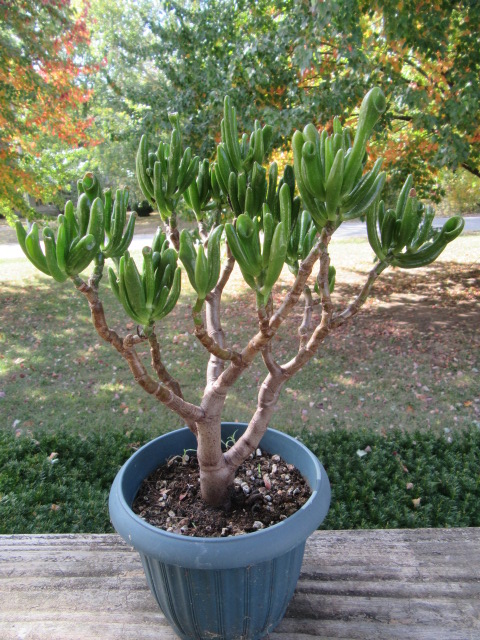
Crassula ovata ‘Gollum’ at 10 1/2 tall x 10″ wide on 10-16-22, #919-7.
The Crassula ovata ‘Gollum’ did very well in its usual spot over the summer on the front porch. I brought this plant home in 2018 when it was 7″ tall and it is now 10 1/2″ tall. I always like the tree-like appearance of older Crassula ovata. I had a fairly large Crassula ovata and a nice C. ovata ‘Lady Fingers’ that were AWESOME!
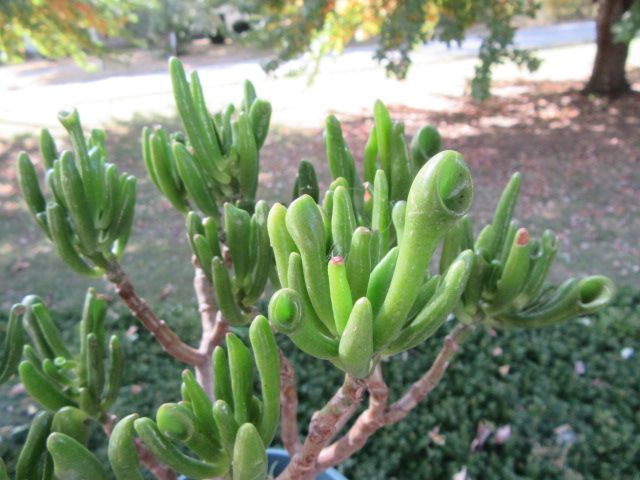
Crassula ovata ‘Gollum’ on 10-16-22, #919-8.
They can attract brown scale (from somewhere) which are easily removed with your fingernail. If you don’t keep an eye on them, the scale can spread to all the leaves and become a pain… Especially when you have a bigger plant with A LOT of leaves
<<<<Echinopsis ‘Rainbow Bursts’>>>>
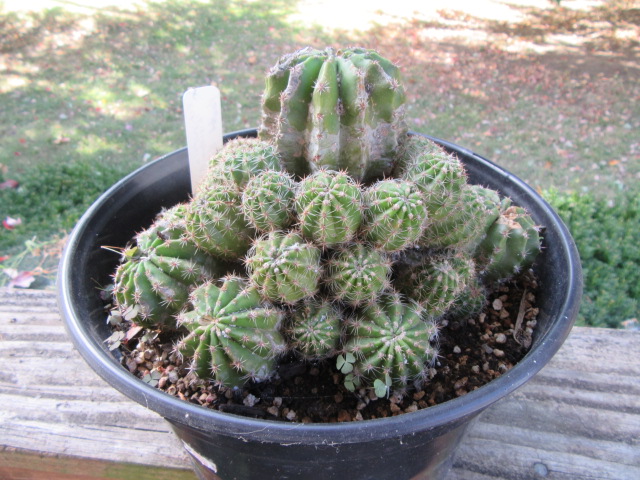
Echinopsis ‘Rainbow Bursts’ at 4 1/4″ tall x 7 1/4″ wide on 10-16-22, #919-9.
The Echinopsis ‘Rainbow Bursts”…GEEZ! I lost my train of thought. I have thought about removing her kids, but then I think about what she would look like all naked. No doubt, her trunk would be all brown and terribly unsightly so I just keep the family together. Someday, I hope to see flowers. After all, I have had this pot since 2016 and who knows how old it was before I brought it home. The main plant was only 2 1/4″ tall x 3 1/2″ wide when I brought it home, and the offsets were growing along its ribs. Now it is 4 1/4″ tall and the whole cluster is 7 1/4″ wide. This plant was originally x Echinobivia ‘Rainbow Bursts’ and was described as an intergeneric cross between Echinopsis and Lobivia. Lobivia is now a synonym of Echinopsis, so I guess it wasn’t an intergeneric cross after all. 🙂 It was named “Rainbow Bursts” because of their “spectacular colors” (so the label said) over the spring and summer. STILL WAITING…
I was watching a YouTube video from Morris Park in the Ozarks a couple of pots that looked similar. With all the offsets and everything.
I still have the big pot of Echinopsis huascha, but they are looking very weird…
<<<<Espostoa melanostele subsp. nana>>>>
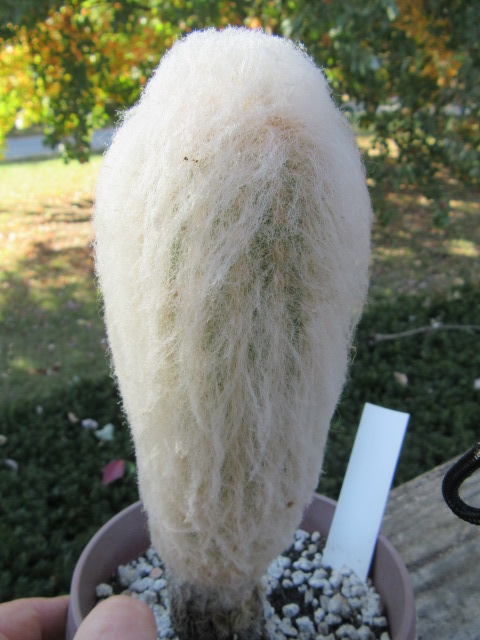
Espostoa melanostele subsp. nana (Peruvian Old Lady)at 9″ tall on 10-16-22, #919-10.
The Espostoa melanostele subsp. nana (Peruvian Old Lady) always seems happy no matter where she is sitting. She may have been happier on the front porch out of the wind so her hair doesn’t get messed up. She has grown another 1/2″ over the summer to 9″ tall. Hard to imagine she was only 2 3/4″ tall when I brought her home in 2016.
<<<<Euphorbia trigona ‘Rubra’>>>>

Euphorbia trigona ‘Rubra’ (African Milk Tree) at 19 1/2″ tall on 10-16-22, #919-11.
To say this Euphorbia trigona ‘Rubra’ has grown would be an understatement. I brought it home from Mast’s Greenhouse in June of 2021 when it was 6 1/4″ tall. By the time I moved the plants inside in October, it had grown to 10 3/4″. Every time I looked at the plants over the summer, I noticed this plant was growing and even had an offset. Well, lately, I had been busy and hadn’t paid much attention to the plants on the front porch. So, when I started moving the plants inside in 2022 I was SHOCKED! This plant had grown to 19 1/2″ tall!
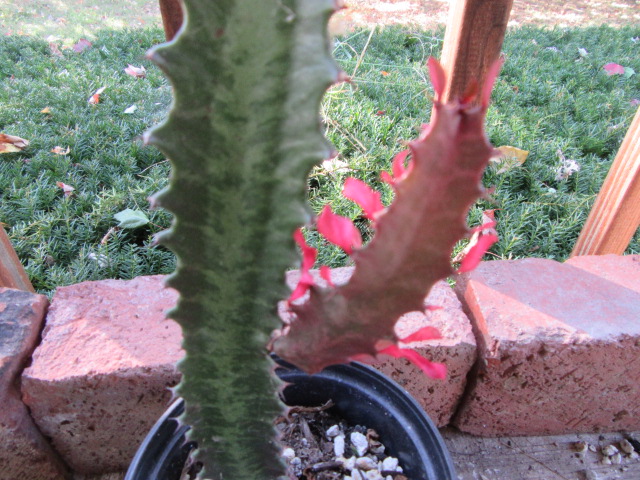
Euphorbia trigona ‘Rubra’ on 10-16-22, #919-12.
Euphorbia trigona was named and described as such by Philip Miller in the eighth edition of The Gardener’s Dictionary in 1768. I don’t know where he found it exactly, but it wasn’t in the wild… You see, there are no known plants of this species in the wild, and it is possibly of hybrid origin. Information also says this species does not produce flowers. Hmmm… As with all Euphorbia, it does produce a milky latex sap.
<<<<Ferocactus wislizeni>>>>
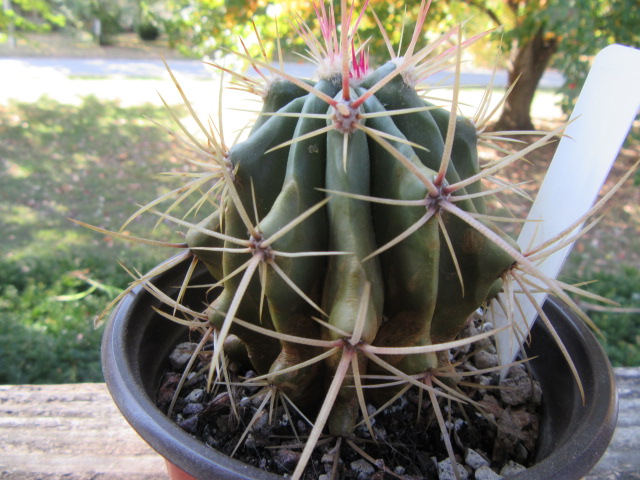
Ferocactus wislizeni (Fishhook Barrel Cactus) at 3 1/8″ tall x 3″ wide on 10-16-22, #919-13.
The Ferocactus wislizeni (Fishhook Barrel Cactus) has done quite well on the front porch and has now reached 3 1/8″ tall. This guy always got a little sunburned on the back porch, but it has had no problems on the front porch. It was only 1 5/8″ tall when I brought it home in 2019, so it has done well.
<<<<x Gasteraloe ‘Flow’>>>
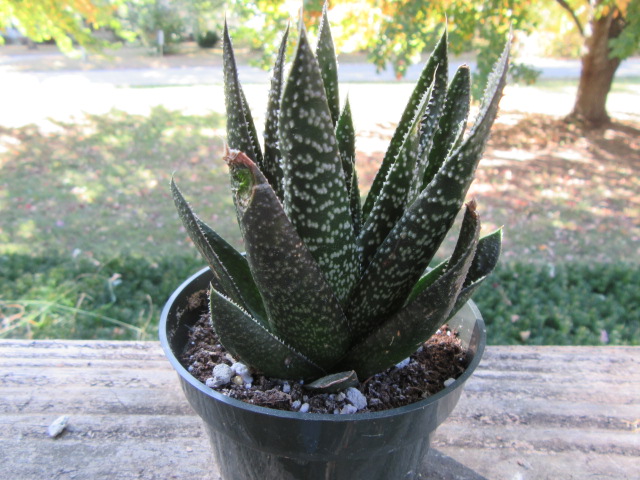
x Gasteraloe ‘Flow’ at 4″ tall x 4″ wide on 10-16-22, #919-14.
I had to throw out my older x Gasteraloe ‘Flow’ in January because of mealybugs. I had sprayed, washed them off, etc. and I finally had to give up. Repeatedly working the plant over seemed to make the plant suffer more (especially during its rest period). I was happy to find a new one at the Kuntry Store in July that was 3″ tall x 3 3/4″ wide. There were some really nice larger plants in combination planters, but I only wanted ‘Flow’. GEEZ, I hate it when that happens. It has grown to 4″ tall x 4″ wide since I brought it home. The plant didn’t have any sort of label, but I am assuming it is x Gasteraloe ‘Flow’.
<<<<Gasteria ‘Little Warty’>>>>
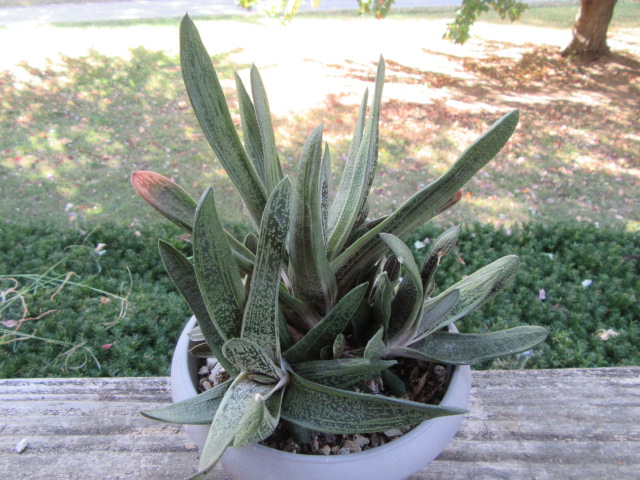
Gasteria ‘Little Warty’ at 6 7/8″ tall x 7 1/8″ wide on 10-16-22, #919-16.
The Gasteria ‘Little Warty’ continued to do well and is now 6 7/8″ tall x 7 1/8″ wide. I really like this little guy. It was only 2″ tall x 2 13/16″ wide when I brought it home in 2019. The mealy bugs tried to infect this plant but had no luck.
<<<<Gasteria sp. ?>>>>

Gasteria sp. at 5 1/4″ tall x 7 1/8″ wide on 10-19-22, #919-16.
I thought I was going to lose this Gasteria last winter because of its issues with mealybugs. It still isn’t quite back to normal but it is OK. It even grew to 5 1/4″ tall x 7 1/8″ wide. I think I may put it in the cool front bedroom with plants that aren’t bothered by critters and keep an eye on it. Maybe I should put it in the basement… I would hate to lose it after almost 5 years. I was kind of surprised it had mealy bug issues since its leaves are so hard, but they attacked way down where the leaves attach. A very hard spot to get to.
<<<<Gymnocalycium saglionis>>>>
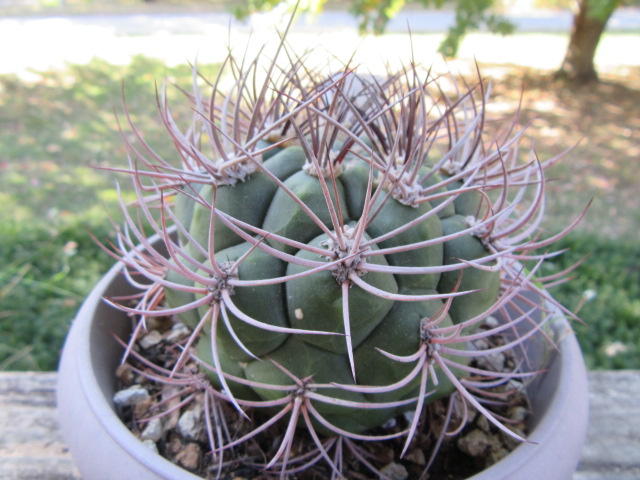
Gymnocalycium saglionis (Giant Chin Cactus) at 2 3/4″ tall x 3 3/4″ wide on 10-16-22, #919-17.
The Gymnocalycium saglionis (Giant Chin Cactus) had never had one single issue. No rust spots, sunburn, bugs, or anything. It has grown from 1 1/8″ tall x 2 5/8″ wide in 2019 to 2 3/4″ tall x 3 3/4″ wide. It had its biggest growth spurt in the first 7 months after I brought it home, and since then it has just grown slow and steady. At least it is still alive and well.
<<<<Haworthiopsis limifolia>>>>
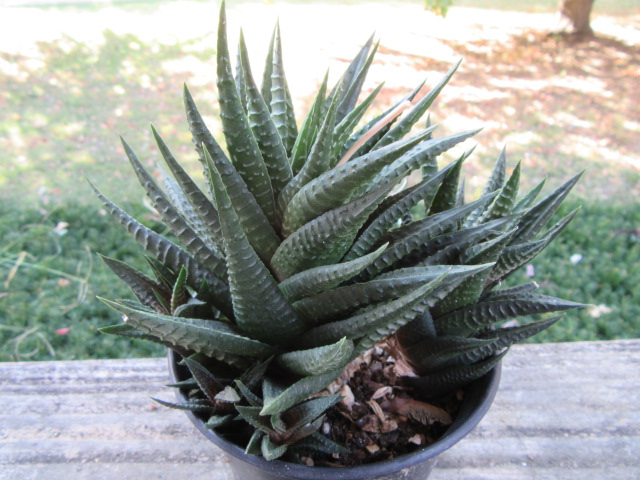
Haworthiopsis limifolia (File-Leaved Haworthia) at 5 1/8″ tall x 6″ wide on 10-16-22, #919-18.
Formerly Haworthia limifolia, the Haworthiopsis limifolia continues to do remarkably well without a hitch. These plants are normally sold under the name Haworthia limifolia ‘Fairy Washboard’, but that is actually a common name along with File-Leaved Haworthia, Fairies Washboard, Swaiti Haworthia, and possibly others. The last name is possibly what it is called in Southeast Africa where the species grows in the wild. There are five varieties of the species… This plant has now grown to 5 1/8″ tall x 6″ wide from 2 3/8″ tall x 3″ wide when I brought it home in May of 2019. Who wouldn’t like its dark green color with all those ridges on the leaves?
<<<<Kalanchoe daigremontiana>>>>
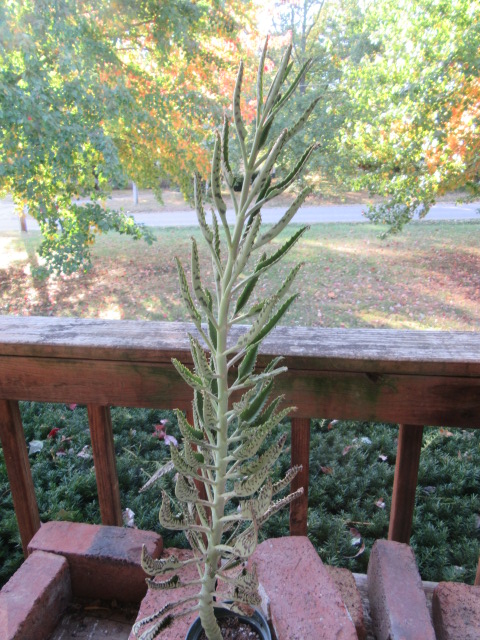
Kalanchoe daigremontiana (Alligator Plant) at 27 3/4″ tall x 7 1/2″ wide on 10-16-22, #919-19.
I finally found a nice Kalanchoe daigremontiana (Alligator Plant). You may remember the “other” Kalanchoe daigremontiana (Mother Of Thousands) I have… I always thought something was a little whacky with the name, and then I finally figured out it was a Kalanchoe laetivirens. Anyway, when I was plant shopping at Wagler’s Greenhouse this summer, I saw they had quite a few of real Kalanchoe daigremontiana. Of course, I had to bring one home… It was 13 1/4″ tall x 13 1/2″ wide when I brought it home in May and now it is a shocking 27 3/4″ tall. Some of the lower leaves have fallen off, so the width has shrunk to 7 1/2″ wide.
Normally, I would have repotted this plant, but since I was a bad parent in 2022 it is STILL in its 4 1/2″ pot I brought it home in. GEEZ! Luckily, it performs a balancing act quite well. It was between two bricks on the plant table, which most of the plants were (or tucked in pot-to-pot) so the wind would blow them around. Right now, it is standing next to the kitchen sink. I am trying to figure out where to put it for the winter…
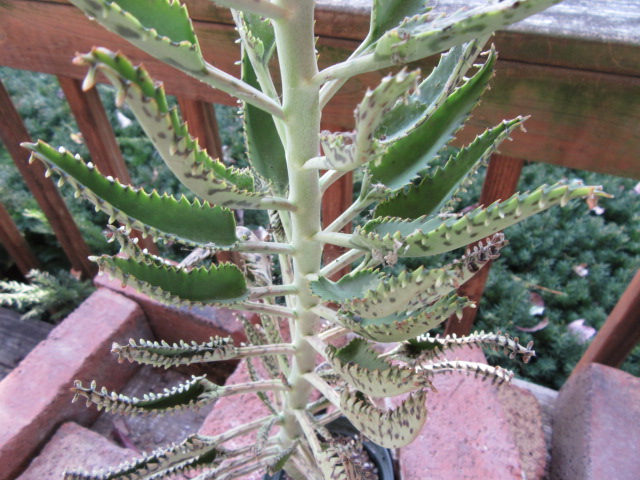
Kalanchoe daigremontiana (Alligator Plant) on 10-16-22, #919-20.
Like the Kalanchoe laetivirens (or x laetivirens since it is a cross between two species), this one also gives birth to plantlets along its leaves (which aren’t really leaves). I removed them before I brought it into the house. I learned a lesson from before…

Kalanchoe daigremontiana (Alligator Plant) on 10-16-22, #919-21.
This species has the purplish marking on its, umm… You know what I mean. A spider decided this plant’s “leaves” made a good home and it was COVERED in webs. I should have taken a photo, but that would have proved my neglect… I guess I could have said it was decorated for Halloween. 🙂 I don’t have a page for this plant yet.
<<<<Kalanchoe thyrsiflora>>>>
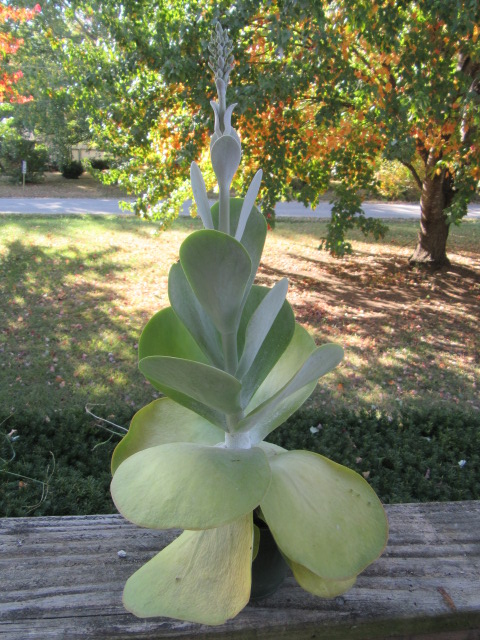
Kalanchoe thyrsiflora (Paddle Plant) at 14 1/4 ” tall on 10-16-22, #919-22.
I found several awesome Kalanchoe thyrsiflora (Paddle Plant) at Mast’s Greenhouse in May and thought I needed to bring one home. I was surprised with buds when I was bringing the plants inside since they weren’t there the week before (unless I wasn’t paying attention). It was 6″ tall x 7 3/4″ wide when I brought it home, and now it is 14 1/4″ tall including the buds. Won’t this be interesting? Ummm… I have no page for this plant yet either.
The Kalanchoe beharensis ‘Fang’, K. laetivirens, all the K. luciae, and K.orgyalis (Copper Spoons) are still alive but need some work… Sadly, the K. gastonis-bonnieri (Donky Ears) and K. beharensis didn’t survive last winter. The K. marmorata (Penwiper Plant) also finally gave it up. We had our ups and downs since 2018.
<<<<Kroenleinia grusonii>>>>
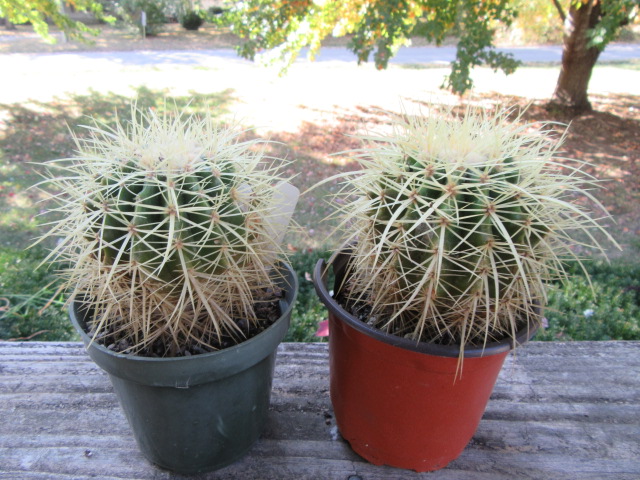
Kroenleinia grusonii (Golden Barrel Cactus)… Greater (green pot) at 3 1/2″ tall x 3 1/4″ wide, and Lessor (orange pot) at 3 3/4″ tall x 3 1/4″ wide on 10-16-22, #919-23.
These two comedians of the group are still alive and well. The Kroenleinia grusonii (Golden Barrel Cactus) both continue growing head to head. I named them Greater and Lessor in 2016 because the one in the green pot has always been a little taller than the other. Lessor, in the orange or red pot (I can’t decide what color it is), has always been a little shorter and wider. Well, this year they are both 3 1/4″ wide, but Lessor is 1/4″ taller than Greater. Of course, they tried their best to convince me they traded pots. Crazy guys! Measuring them is tricky enough with them jiggling around and standing on their toes.
Apparently, the orange spots on these two guys was rust. Rust can be treated if you know what it is in the first place. Well, the rust issue has gone away, and the orange spots have turned white. Now that I know what it was, I will keep an eye on them.
<<<<Mammillaria hahniana>>>>
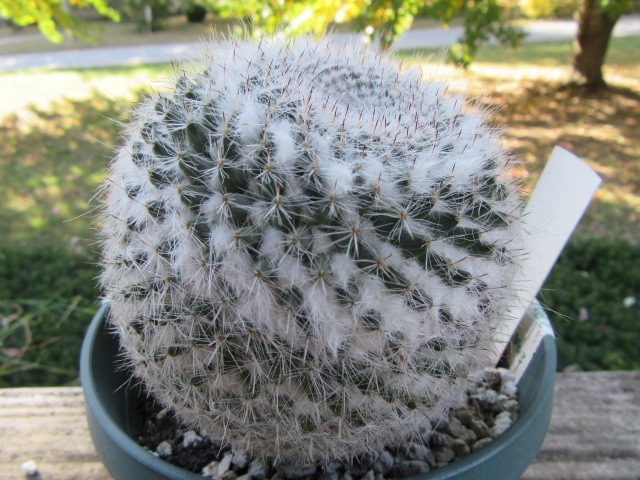
Mammillaria hahniana (Old Lady Cactus) at 5 1/2″ tall x 3 3/8″ wide on 10-16-22, #919-24.
This Mammillaria hahniana (Old Lady Cactus) is now the oldest Mammillaria in my collection since M. pringlei and M. rhodantha died. This awesome cactus has now grown to 5 1/2″ tall x 3 3/8″ wide from 1 7/8″ tall x 2 3/8″ wide in 2016. It has been a great cactus and is a free bloomer when it gets in the mood. Old Woman Cactus is the common name iNaturalist gives this species…
<<<<Mammillaria karwinskiana>>>>
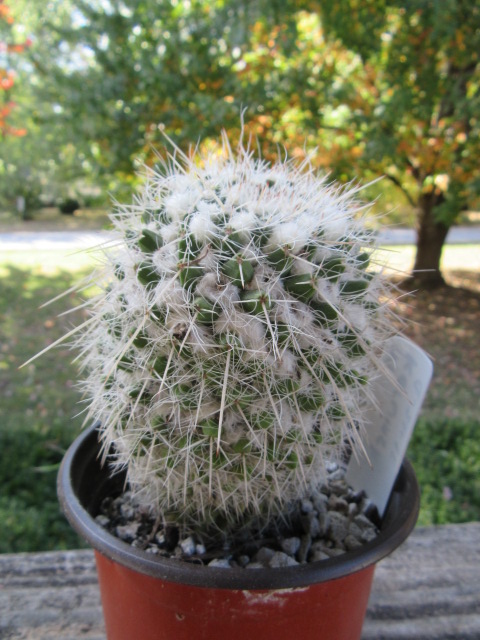
Mammillaria karwinskiana (Silver Arrows) at 4 1/2″ tall x 3 1/2″ wide on 10-16-22, #919-25.
When I was measuring Mammillaria karwinskiana (Silver Arrows) it told me it had an itch and asked me to give it a scratch. I was kind of speechless. It has barely ever spoken to me and now it wants a scratch. GEEZ! It just as well ask for a massage. Anyway… This cactus has done very well and has grown another 1/2″ taller and is about the same width as last year. It now stands at 4 1/2″ tall and is 3 1/2″ wide. To think it was just 1 7/8″ tall x 2 3/16″ when I brought it home in 2019. I really like its wool, hairiness, and those long, straight, white spines. But a scratch is out of the question.
<<<<Mammillaria muehlenpfordtii>>>>

Mammillaria muehlenpfordtii (Golden Pincushion) at 5 1/4″ tall x 3″ wide on 10-16-22, #919-26.
The Mammillaria muehlenpfordtii (Golden Pincushion) has been a great plant since I brought it home from Lowe’s in September in 2019. Its pot was lying on the plant shelf with the plant not even in the pot. I am sure it appreciates being brought home. I have always admired its blue-green color and all those golden spines, but the long central spines and short radial spines are also neat. It has grown to 5 1/4″ tall x 3″ wide and was 3 1/4″ tall x 2 1/8″ wide when I brought it home.
<<<<Mammillaria mystax>>>>
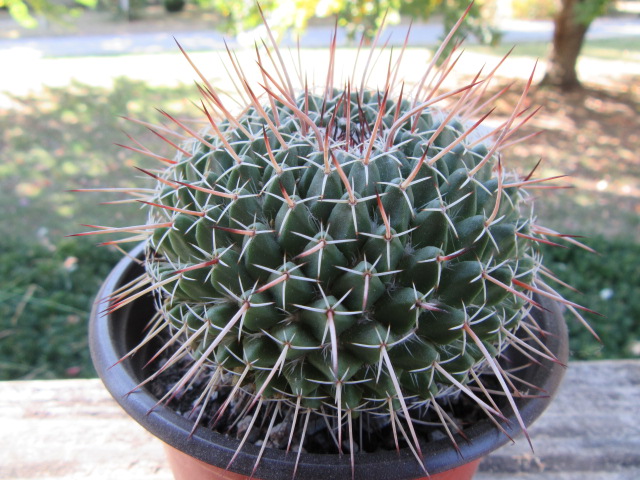
Mammillaria mystax at 2 3/4″ tall x 3 1/8″ wide on 10-16-22, #919-27.
Very funny… The Mammillaria mystax shrunk! The measurement from last year was 3 1/4″ tall x 3 1/4″ wide and now it is 2 3/4″ tall x 3 1/8″ wide. Heck, it was 2 3/4″ tall in 2020. It has grown quite a bit, though, since it was just 1 3/4″ tall x 2 1/4″ wide when I brought it home in 2018. Sometimes that happens with cacti when they don’t have enough water. That is likely the case since they were under the roof of the front porch and most of the time just received rain as it blew in on them. I am not complaining that it shrunk especially since it is partly my fault. OK, it was likely all my fault. But, it was safe from the scorching sun on the front porch which I know it appreciated. How do I know? Well, it was smiling at me when I measured it and took its photo.
<<<<Mammillaria plumosa>>>>
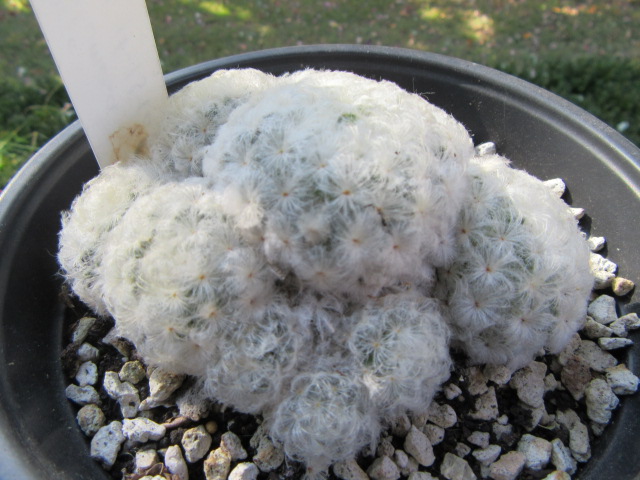
Mammillaria plumosa (Feather Cactus) at 2″ tall x 4 1/4″ wide on 10-16-22, #919-28.
It is certainly a good thing this Mammillaria plumosa (Feather Cactus) hasn’t had any problems with mealybugs. How would you tell? I bought this cactus from a seller on Ebay in 2018 and it has been great. In fact, it is the only cactus I bought from Ebay that has survived. Even though it was very small at 3/4″ tall x 2 1/4″ wide it has done very well. The main plant has grown to 2″ tall and the whole cluster is now 4 1/2″ wide. This one you can pet if you so desire…
I lost several Mammillaria since last winter including M. decipiens (Bird’s Nest Cactus) that did very well since 2018, M. elongata (Lady Finger Cactus) that I brought home in 2018, M. pringlei and M. rhodantha I already mentioned, M. senilis (the one with the hooked spines I could never tell if it was alive or dead) since 2020, both M. vetula including ‘Arizona Snowcap’, and M. compressa from 2020. The M. spinosissima ‘Un Pico’ is still alive but looks terrible with A LOT of rust or something… One of the plants in the pot of 3 already died… I have learned that even though many species of Mammillaria are some of the best cacti to grow, when you bring home very small plants you are taking a risk. Also, many species on the market haven’t been in cultivation that long and may not be good choices. Big growers plant seeds by the thousands and don’t necessarily care if they are good choices for pot culture. These days some companies aren’t even putting the names on the pots because they have no clue.
<<<<Opuntia monacantha var. variegata>>>>
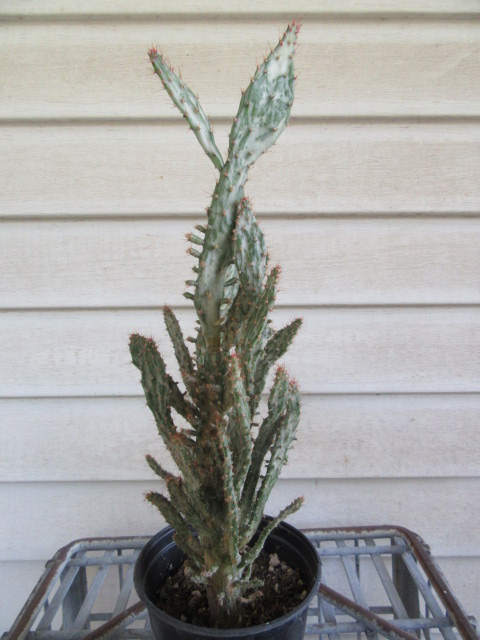
Opuntia monacantha var. variegata (Joseph’s Coat) at 12 3/8″ tall x 4 1/2″ wide on 10-16-22, #919-29.
You know, I really haven’t been into variegated cacti, but this Opuntia monacantha var. variegata (Joseph’s Coat) I saw at Wagler’s Greenhouse in 2020 caught my eye. It was only 4 3/4″ tall when I brought it home, and it has grown to 12 3/8″. It is very interesting…
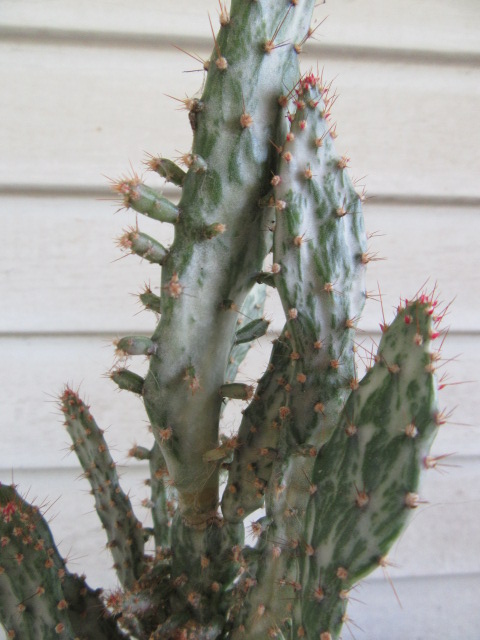
Opuntia monacantha var. variegata (Joseph’s Coat) on 10-16-22, #919-30.
Actually, Llifle (Encyclopedia of Living Forms) has it listed as Opuntia monacantha f. monstruosa variegata (syn. Opuntia monacantha var. variegata cv. Maverick variegata). Which is a synonym of Opuntia monacantha… You know, someone always has to give it a cultivar name when it isn’t necessarily a cultivar. It is one of very few naturally occurring variegated cacti and it is a monstrose form. It is a dwarf, teratological variant of the larger Opuntia monacantha. Anyway, something weird is going on with its main stem… What are those protruberances? Could they be buds? I checked out photos on iNaturalist for the species and that could be very possible… Time will tell and keep your fingers crossed they don’t fall off if they are buds. You never know since I moved it into the house in a different light.
<<<<Parodia lenninghausii>>>>
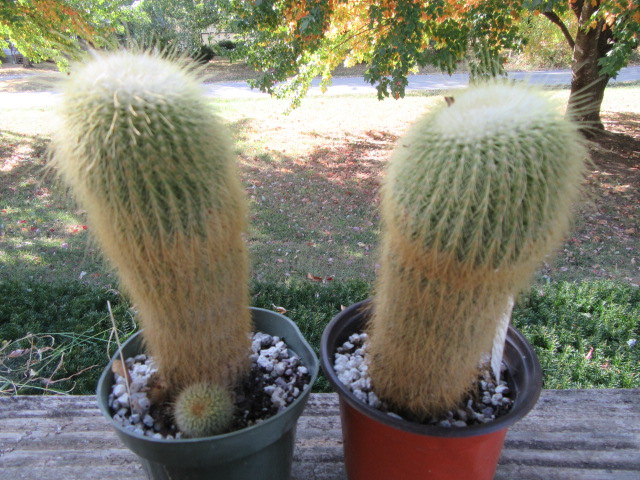
Parodia lenninghausii, the orange pot on the right is 6 1/2″ tall x 2 3/4″ wide, and the green pot on the left is 7″ tall x 2 1/8″ wide on 10-16-22, #919-31.
The two Parodia lenninghausii (Golden Ball or Lemon Ball Cactus) are more serious than the two Kroenleinia grusonii, but they do have their moments. Sometimes these two agree with each other, and at other times they seem to have had a disagreement and won’t even look at each other. I kind of screwed up and named them Greater and Lessor as well, so I may have to change that. They have also done the switch… Lessor, in the green pot, is now taller than Greater… Lessor is now 7″ tall x 2 1/8″ wide, and Greater is 6 1/2″ tall x 2 1/8″ wide. Hmmm… I have been enjoying these two since 2-1-16. That was when I bought several cacti from Walmart and didn’t notice I bought two Parodia lenninghausii and two Kroenleinia grusonii until I was home… I am glad I brought two of each home to compare with each other as they grow.
<<<<Parodia magnifica>>>>
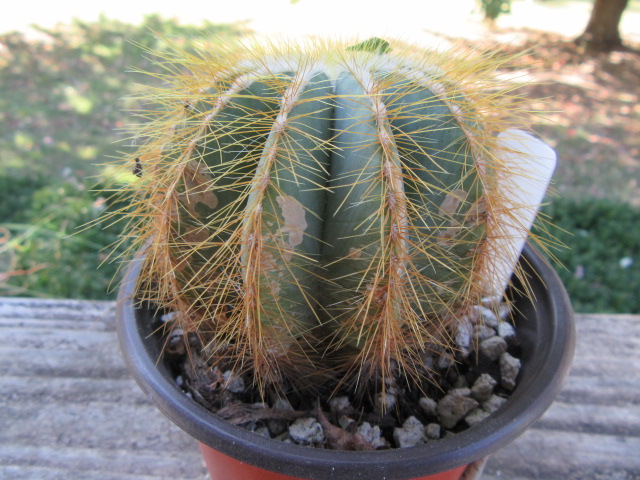
Parodia magnifica (Ball or Balloon Cactus) at 2 7/8″ tall x 3 1/8″ wide on 10-16-22, #919-32.
The Parodia magnifica (Ball or Balloon Cactus) has done very well and has grown to 2 7/8″ tall but has shrunk 1/8″ to 3 1/8″ wide. It has a few brown spots that I am not sure what the cause is. I was watching a video on YouTube from Morris Park in the Ozarks where he talked about several issues with his cactus. This could be scarring from getting cold or perhaps from stretching as it grows… Apparently, it isn’t hurting it since it is growing and seems healthy otherwise. The marks are smooth without any sign of any kind of infection, past or present.
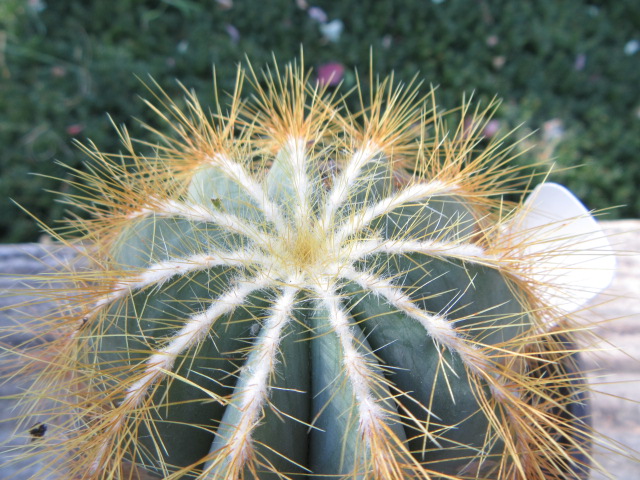
Parodia magnifica from the top on 10-16-22, #919-33.
I really like the top view with its wool along the tips of the ridges and golden spines.
<<<<Polaskia chichipe>>>>
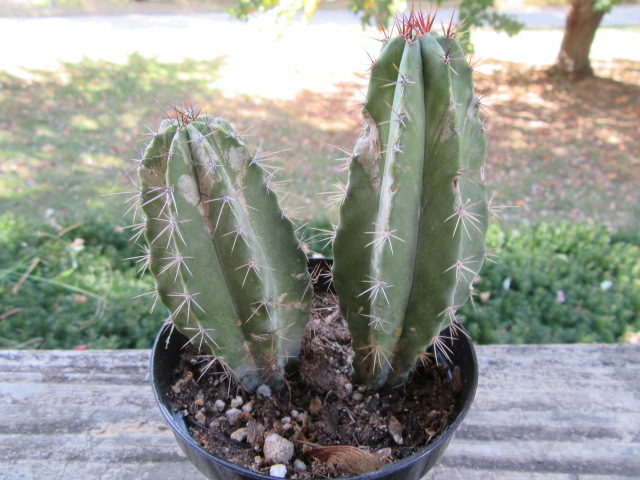
Polaskia chichipe (Chichipe), the taller plant on the right was 3 7/8″ tall x 1 1/2″ wide, and the one on the right was 3 1/4″ tall x 2 5/8″ wide on 10-16-22, #919-34.
The Polaskia chichipe (Chichipe, ETC.) has done pretty well considering they don’t look that great. I’m not sure what happened to the one on the left, but the one on the right had straw flower damage. You know, those silly fake flowers they stick on with some kind of glue. Perhaps the other marks are naturally occurring as the plants grow. The big scar on the one on the right is likely from the straw flower. There were three plants in the pot, but one died last winter. The plant on the right now measures 3 7/8″ tall x 1 1/2″ wide, while the one on the left is 3 1/4″ tall x 2 5/8″ wide.
<<<<Stenocereus pruinosus>>>>
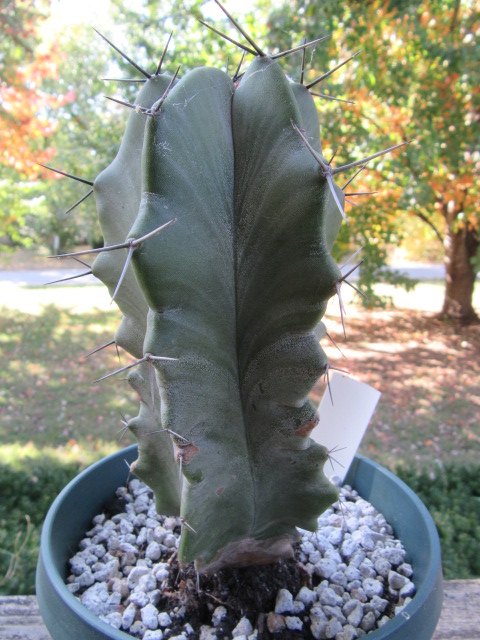
Stenocereus pruinosus (Gray Ghost, ETC.) at 6 1/4″ tall x 3 1/8″ wide on 10-16-22, #919-35.
The Stenocereus pruinosus (Gray Ghost, Organ Pipe, ETC.) is still alive and well. This has been a great cactus. It now measures 6 1/4″ tall x 3 1/8″ wide from 2 7/8″ tall x 2 3/4″ wide when I brought it home in 2016. I always liked the V-shaped pattern on its trunk. This seems to be an easy-to-grow species, so if you find one…
<<<<Tephrocactus articulatus var. papyracanthus>>>>
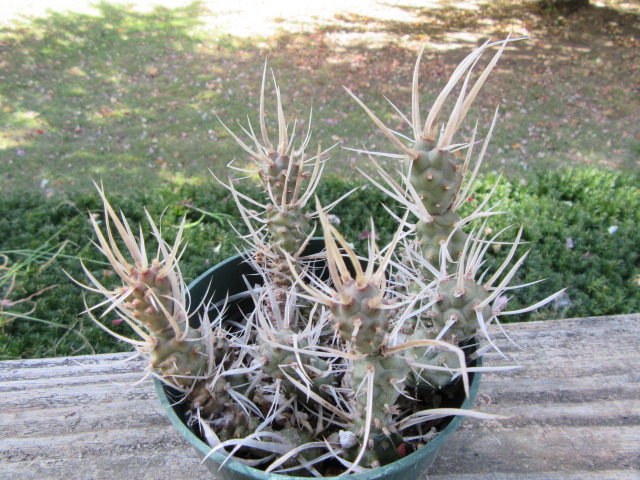
Tephrocactus articulatus var. papyracanthus (Paper Spine Cactus) on 10-16-22, #919-36.
The Tephrocactus articulatus var. papyracanthus is always the last on the list but is usually one of the first to be photographed. This Paper Spine Cactus caught my eye when I was plant shopping at Walmart on February 9 in 2016 because of its unusual spines. I was about to put it in my cart when I found a segment lying on the shelf. I decided to take the segment and put the pot back on the shelf. It has been very interesting to watch grow to say the least.
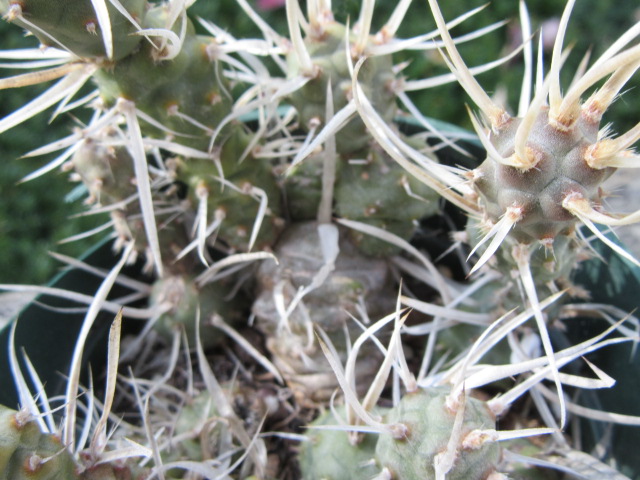
Tephrocactus articulatus var. papyracanthus (Paper Spine Cactus) on 919-37.
In the wild, their segments fall off and take root wherever they land. If an animal passes by, they also hitch a ride on its fur and do a little traveling. When I notice a segment has fallen off I just face it upward in the pot and it takes root. It has done well for the last couple of years and none of the segments have fallen off. The tallest has made it to 4″ tall without falling apart. The pot is getting crowded, so I should give it more space. Ummm… It has been in this pot since 2018. I did put a segment that had fallen off into another pot and it is doing well. I may give it to Mrs. Wagler of Wagler’s Greenhouse since we share plants. I haven’t seen any of these for sale at Wal-Mart or Lowe’s since 2016, so I am very glad I brought the stub home.
Overwintering “desert” cactus isn’t that hard as long as you don’t water them. If you do, just a little no more than once a month )or so) is sufficient. Tropical cacti, like Christmas Cactus and Epiphyllum, need a comfortable temperature and pretty much regular watering. I still have the three Epiphyllum that Tony Tomeo sent and they are doing well. They are quite interesting and somewhat entertaining. One was on the front porch and two on the back porch over the summer with the Stapelia gigantea. The Schlumbergera have had their ups and downs over the summer because they didn’t get enough water (bad parenting). One has buds already and it was outside!
Anyway, there are many websites online about overwintering cacti inside. Reading one is sufficient because if you read several you might be confused. The care they suggest is somewhat controversial especially as far as the temperature. Once temps outside cools off and the day length decreases, they go into dormancy mode. I always put them somewhere the temperature will be about the same when I bring them in. You don’t really want to bring them in from 40° F outside temp to 70° inside. Typically, I water them pretty well a week or so before I bring them inside so I won’t have to water them for a while. Well, I didn’t do that this time because I simply screwed up then evening temps started getting too cool. The debate right now is do I put the cactus in the south-facing window in a cool bedroom, or the west-facing window in the front bedroom, also kept cool. Cool temps do help control parasites, but the light really doesn’t matter because the cactus are sort of dormant. Then again, the cactus did fine with no parasite issues until last winter, and only a few at that. Cactus don’t like to be bothered with sprays over the winter. At least that is my opinion.
Anyway, I will close for now. I have two posts in the making. One about Euphorbia (wildflowers) and the other about the Symphyotrichum species on the farm. I am waiting for the Euphorbia dentata and E. davidii seeds to dry which will determine the species. At least I hope. Both genera have been quite entertaining.
Until next time, be safe, stay positive, and always be thankful!
